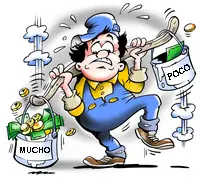

Lesson 20 - Comida (Food)
Navigation: Home
→ Course
→ Lesson 20
→ mucho/poco
Pages in this lesson: Food - mucho/poco - Dialogue - Reading - Quiz
This page: Learn how to use the words mucho and poco as adjectives and adverbs. Also, learn how to use the word ending -ísimo to make a word emphatic.

mucho/poco
Grammar Lesson
The words mucho (a lot/much) and poco (a little/a few) can be used as adjectives or adverbs.
mucho and poco as adjectives
When used as adjectives, the words mucho and poco have to agree in gender (masculine/feminine) and number (singular/plural) with the noun. Unlike most adjectives in Spanish, mucho and poco go before the noun, not after.
- Mucho
- Tenemos mucho dinero. = We have a lot of money.
- Ella tiene mucha comida. = She has a lot of food.
- Como muchos plátanos. = I eat a lot of bananas.
- Mi hija come muchas uvas. = My daughter eats a lot of grapes.
- Poco
- Tenemos poco dinero. = We have a little money.
- Ella tiene poca comida. = She has a little food.
- Como pocos plátanos. = I eat few bananas.
- Mi hija come pocas uvas. = My daughter eats few grapes.
Practice
Section 1
Do you have a lot or a little of these things in your house right now? If you have a medium amount or none, just pick one (mucho or poco) so that you can practice. Make sure that mucho or poco agrees in gender (masculine/feminine) and number (singular/plural) with the noun. Don't forget to use correct capitalization, accents and punctuation, or the computer will mark it as incorrect.
- Examples
- manzanas → Tengo muchas manzanas.
- yogur → Tengo poco yogur.
mucho and poco as adverbs
The words mucho and poco can also be used as adverbs to modify the verb. When used as an adverb, the word mucho or poco is always in the singular masculine form.
- Ella estudia mucho antes de un examen. = She studies a lot before a test.
- Los niños comen poco. = The children eat little.
Practice
Section 2
Do you do these activities a lot or a little? Write a sentence with mucho or poco as an adverb.
- Examples
- estudiar (study) → Estudio mucho.
- cocinar (cook) → Cocino poco.
-ísimo
The ending -ísimo can be added to the ending of adjectives or adverbs to make them emphatic. Both of the sentences below are translated as, "She studies a lot." because we don't have an equivalent of -ísimo in English. The difference is that muchísimo is emphasizing that she studies really A LOT (hours and hours).
- Ella estudia mucho. = She studies a lot.
- Ella estudia muchísimo. = She studies a lot.
Rules for adding the ending -ísimo
1) If a word ends in a consonant, just add the ending -ísimo.
- popular → popularísimo
2) If a word ends in a vowel, remove the final vowel before adding -ísimo.
- pobre → pobrísimo
3) If the final consonant before adding -ísimo is a letter C, G or Z, you will need a spelling change (outlined below).
- C → QU (to maintain the hard K sound)
- rico → riquísimo
- G → GU (to maintain the hard G sound)
- largo → larguísimo
- Z → C
- feliz → felicísimo
4) If the word normally has an accent, the accent is removed because -ísimo has an accent.
- difícil → dificilísimo
5) Like other adjectives, the letter O at the end changes when used with a feminine or plural noun.
- un libro buenísimo (masculine singular)
- libros buenísimos (masculine plural)
- una clase buenísima (feminine singular)
- clases buenísimas (feminine plural)
Practice
Section 3
Change the adjective to the emphatic form. For this exercise, put all of them in the masculine singular form (-ísimo).
Practice
Section 4
Change the adjective to the emphatic form AND make it agree in gender and number with the noun.
Find the mistake in the sentence and re-write it correctly in the space. Don't forget to use correct capitalization, accents and punctuation, or the computer will mark it as incorrect.
|
Writing
Write five sentences using mucho or poco as an adjective or adverb. If you want to type a special character (like an accented letter) in the comments section, you could do one of the following . . .
- Select and copy the character that you need → á é í ó ú ü ñ ¿ ¡ Á É Í Ó Ú Ü Ñ « »
- Use special codes on your computer if you have numeric keypad (instructions HERE).
- Type your sentences into the text box below and use the special character buttons provided. Then select and copy your text and paste it into the comments section.
If you see an error in someone else's sentence, please respond with the correction. Comments that are not from "Janet Castrejon" (the author of this page) do not represent Simplified Spanish. If someone is writing inappropriate comments on this webpage, please send a message to [email protected] and include the page that you saw the comment on.
Lesson 20 - Comida (Food)
Food - mucho/poco - Dialogue - Reading - Quiz
Important Links
Pronouns - Pronunciation - Verbs



